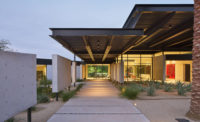The Phoenix-based architect Wendell Burnette is known for designing buildings with a keen sense of place, whether it’s a galvanized zinc box of a house that sits on a flat Wisconsin crop field or the house shown here, on a five-acre site in a desert valley north of Cave Creek, Arizona. Designed as an emptynest home for Keith and Kim Meredith, the distinctive structure defines, Burnette says, “the core concept of how we live in the desert.” His clients, whom he describes as “into Eastern philosophy, paring down, and being close to nature,” had no interest in a conventional house. Since their children are grown, the residence has only one bedroom and a fairly small, flexible living/dining/cooking area, as well as outdoor cooking/dining, exercise, and seating spaces. Sometimes, Burnette says, the indoor and outdoor spaces “are completely seamless.”
Burnette took the site’s most prominent feature—an outcrop of pink schist that runs along the east edge of the site—and extended it conceptually with a “plinth” of plaster-clad masonry that forms the base of the 3,125- square-foot house (and contains the lower-level garage, library, and exercise spaces, among others). Next, what Burnette terms “a dispersed core” is made up of a cluster of solid forms, with wood structures that are clad variously in steel, stucco, and resin-infused paper. These forms define the entry, which incorporates a steel-mesh aviary that greets visitors with the sound of birdsong, and the living areas on the house’s east side—including an indoor porch with a fireplace where the Merediths like to sit with a bottle of wine (the space doubles as a solar heat collector in winter). This also minimizes the amount of perimeter glass. On the west side are the dressing room, bathroom, soaking-tub room, meditation room, and bedroom. The bedroom faces west, Burnette explains, to avoid the direct light of sunrise for “a more gentle process of waking up.” Above it all is the “canopy,” a 3,000-square-foot roof structure that contains photovoltaics (which allow close to net zero energy consumption), mechanical equipment, and water-harvesting features. Its depth and bulk are balanced by a mill-finished stainless-steel fascia that reflects the landscape and sky and which splits open to mark the house’s entrance. The canopy’s underside, from edge to edge, is a continuous expanse of black theatrical fabric with sound insulation behind it; this indoor-outdoor fabric ceiling, which is also pierced by thin skylights, is relatively low because of building height restrictions in the area.
The plan of the house, which, Burnette says, “is about small spaces pinwheeling to frame different views, not one big room for one big view,” was influenced by desert architecture in places like North Africa. “The program has different orientations for different times of day,” he adds, “and you move with those rhythms.”






















